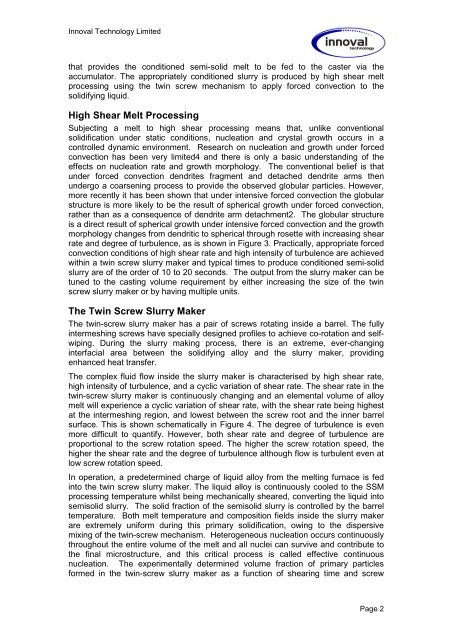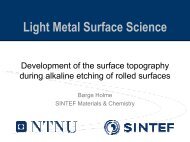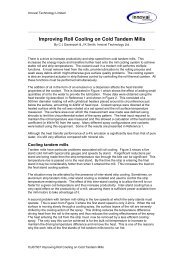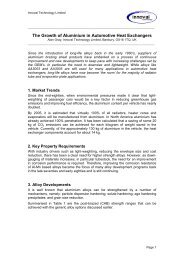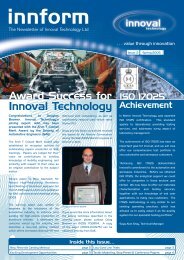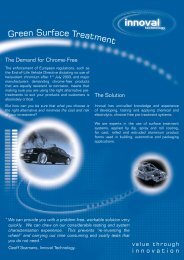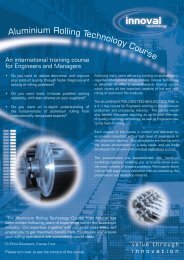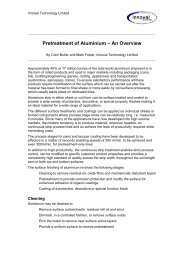Twin Roll Rheocasting of Aluminium Alloys - Innoval Technology Ltd
Twin Roll Rheocasting of Aluminium Alloys - Innoval Technology Ltd
Twin Roll Rheocasting of Aluminium Alloys - Innoval Technology Ltd
Create successful ePaper yourself
Turn your PDF publications into a flip-book with our unique Google optimized e-Paper software.
<strong>Innoval</strong> <strong>Technology</strong> Limited<br />
that provides the conditioned semi-solid melt to be fed to the caster via the<br />
accumulator. The appropriately conditioned slurry is produced by high shear melt<br />
processing using the twin screw mechanism to apply forced convection to the<br />
solidifying liquid.<br />
High Shear Melt Processing<br />
Subjecting a melt to high shear processing means that, unlike conventional<br />
solidification under static conditions, nucleation and crystal growth occurs in a<br />
controlled dynamic environment. Research on nucleation and growth under forced<br />
convection has been very limited4 and there is only a basic understanding <strong>of</strong> the<br />
effects on nucleation rate and growth morphology. The conventional belief is that<br />
under forced convection dendrites fragment and detached dendrite arms then<br />
undergo a coarsening process to provide the observed globular particles. However,<br />
more recently it has been shown that under intensive forced convection the globular<br />
structure is more likely to be the result <strong>of</strong> spherical growth under forced convection,<br />
rather than as a consequence <strong>of</strong> dendrite arm detachment2. The globular structure<br />
is a direct result <strong>of</strong> spherical growth under intensive forced convection and the growth<br />
morphology changes from dendritic to spherical through rosette with increasing shear<br />
rate and degree <strong>of</strong> turbulence, as is shown in Figure 3. Practically, appropriate forced<br />
convection conditions <strong>of</strong> high shear rate and high intensity <strong>of</strong> turbulence are achieved<br />
within a twin screw slurry maker and typical times to produce conditioned semi-solid<br />
slurry are <strong>of</strong> the order <strong>of</strong> 10 to 20 seconds. The output from the slurry maker can be<br />
tuned to the casting volume requirement by either increasing the size <strong>of</strong> the twin<br />
screw slurry maker or by having multiple units.<br />
The <strong>Twin</strong> Screw Slurry Maker<br />
The twin-screw slurry maker has a pair <strong>of</strong> screws rotating inside a barrel. The fully<br />
intermeshing screws have specially designed pr<strong>of</strong>iles to achieve co-rotation and selfwiping.<br />
During the slurry making process, there is an extreme, ever-changing<br />
interfacial area between the solidifying alloy and the slurry maker, providing<br />
enhanced heat transfer.<br />
The complex fluid flow inside the slurry maker is characterised by high shear rate,<br />
high intensity <strong>of</strong> turbulence, and a cyclic variation <strong>of</strong> shear rate. The shear rate in the<br />
twin-screw slurry maker is continuously changing and an elemental volume <strong>of</strong> alloy<br />
melt will experience a cyclic variation <strong>of</strong> shear rate, with the shear rate being highest<br />
at the intermeshing region, and lowest between the screw root and the inner barrel<br />
surface. This is shown schematically in Figure 4. The degree <strong>of</strong> turbulence is even<br />
more difficult to quantify. However, both shear rate and degree <strong>of</strong> turbulence are<br />
proportional to the screw rotation speed. The higher the screw rotation speed, the<br />
higher the shear rate and the degree <strong>of</strong> turbulence although flow is turbulent even at<br />
low screw rotation speed.<br />
In operation, a predetermined charge <strong>of</strong> liquid alloy from the melting furnace is fed<br />
into the twin screw slurry maker. The liquid alloy is continuously cooled to the SSM<br />
processing temperature whilst being mechanically sheared, converting the liquid into<br />
semisolid slurry. The solid fraction <strong>of</strong> the semisolid slurry is controlled by the barrel<br />
temperature. Both melt temperature and composition fields inside the slurry maker<br />
are extremely uniform during this primary solidification, owing to the dispersive<br />
mixing <strong>of</strong> the twin-screw mechanism. Heterogeneous nucleation occurs continuously<br />
throughout the entire volume <strong>of</strong> the melt and all nuclei can survive and contribute to<br />
the final microstructure, and this critical process is called effective continuous<br />
nucleation. The experimentally determined volume fraction <strong>of</strong> primary particles<br />
formed in the twin-screw slurry maker as a function <strong>of</strong> shearing time and screw<br />
Page 2


